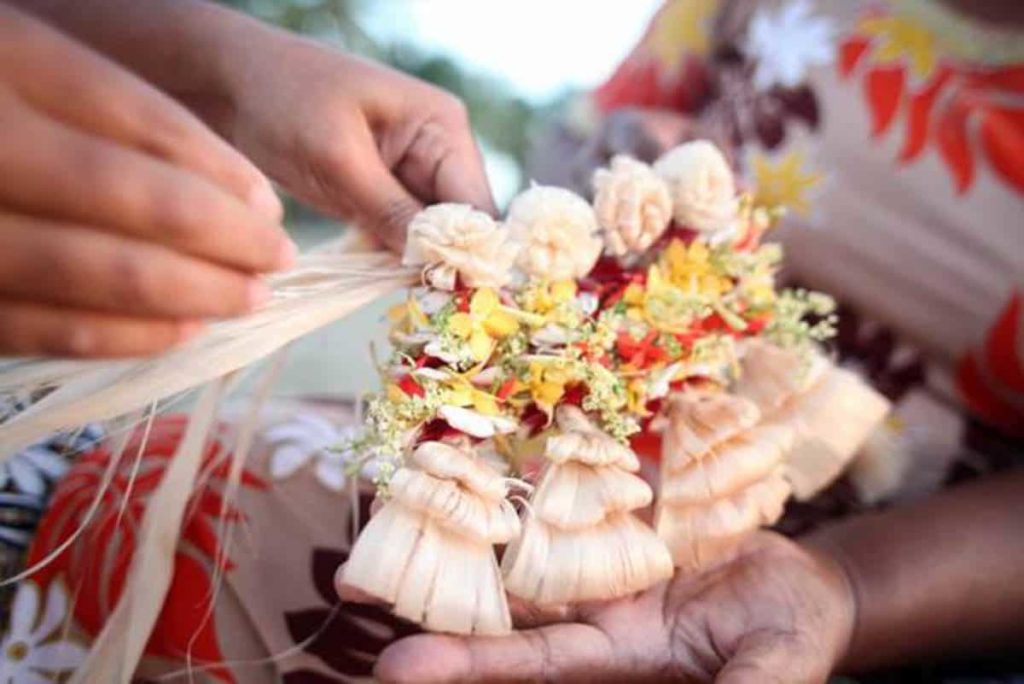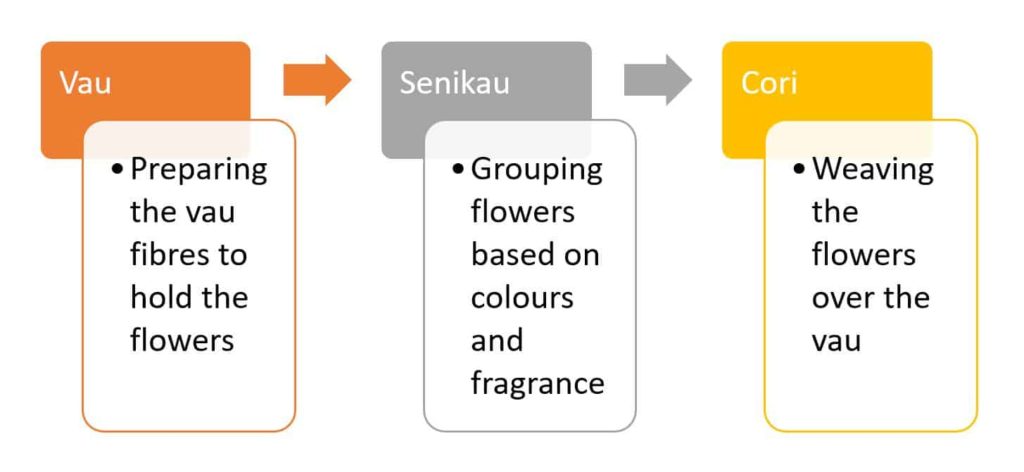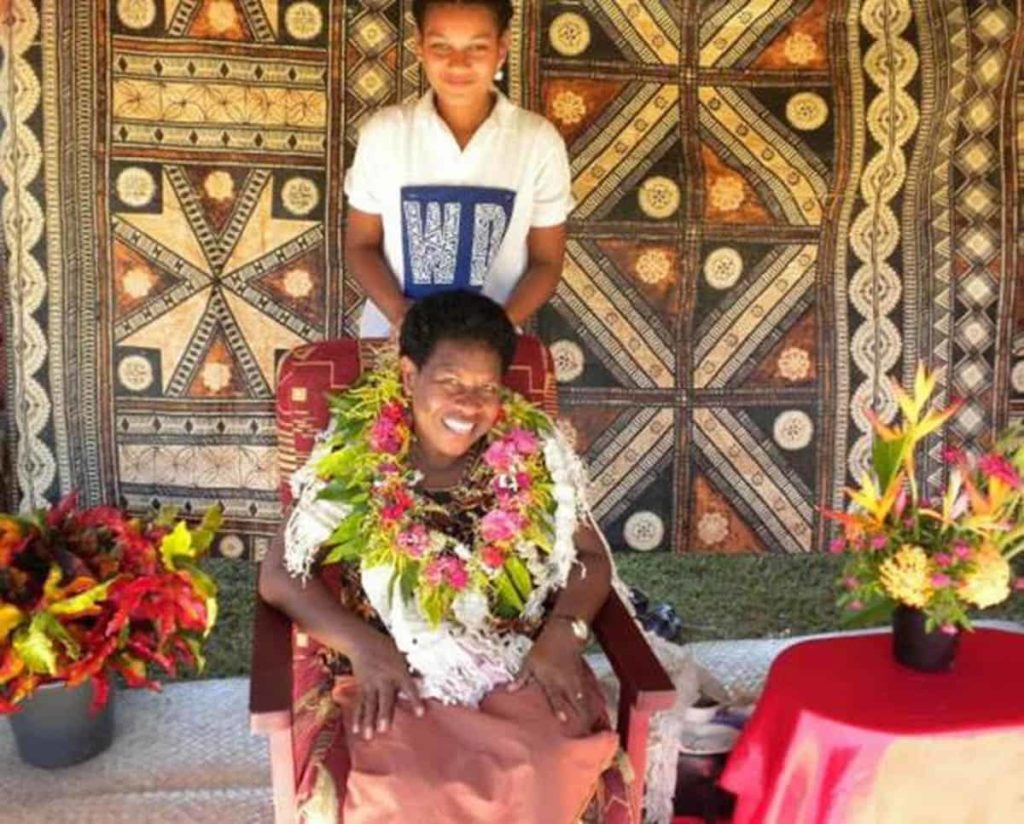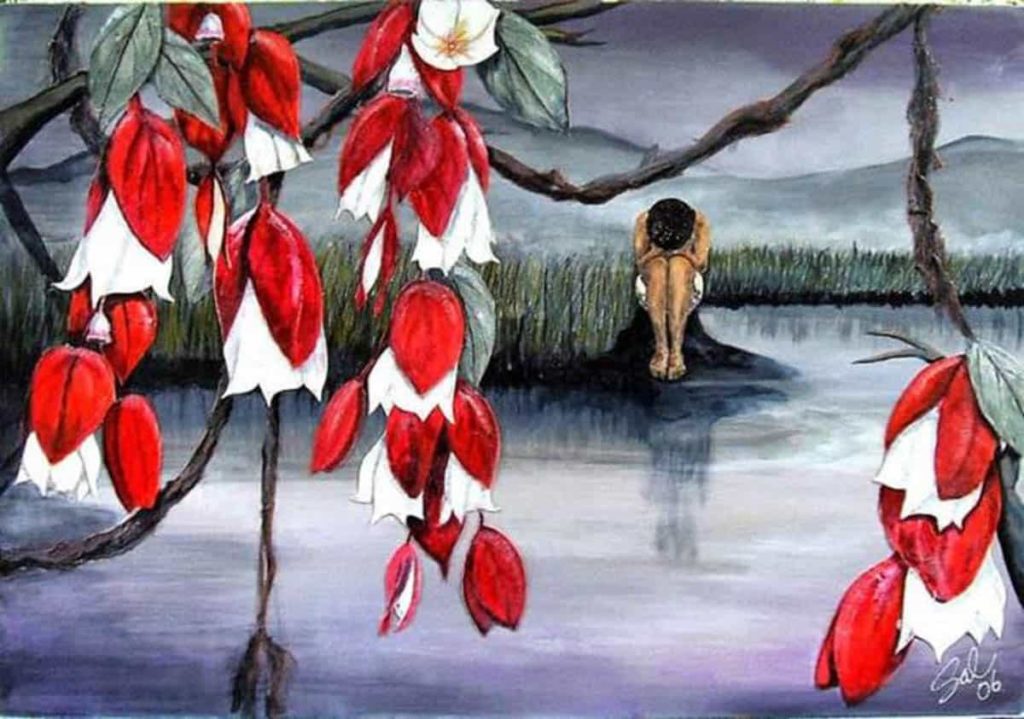Salusalu (pronounced as sar-loo-sar-loo) is Fijian for garland. It can be described as a necklace of flowers woven together by strands of vau (dried bark of wild hibiscus). A salusalu is made from colourful and scented flowers and is commonly worn around the neck and presented to a visitor as a sign of one’s appreciation.
Historically, salusalu is also made and worn to celebrate rites of passage and key ceremonies. The traditions of salusalu making have been in existence for many centuries. The processes of creating, presenting and adorning these floral necklaces signifies family lineage, traditional roles and cultural affiliation. It is also important to know that salusalus are ranked in the sense that some are worn on formal occasions while others can be made and worn for informal use. We are blessed today that the tradition of creating, presenting and wearing salusalu is still practised. In this essay, I will be discussing these three processes, supported by relevant examples from Fiji. The purpose of this article is to highlight the historical significance of salusalu to indigenous Fijians.

The Republic of Fiji is made up of 322 islands spread over 194,000 square kilometres. Around 110 of these islands are inhabited. These islands are a mixture of volcanic and limestone islands, hence the variation of vegetation, flora and fauna. Fijians, over 3000 years of habitation on these islands, adapted to these environments. Part of this adaptation included the naming of plants and flowers. Some islands have endemic plants, which means that they exist only in this particular region. One example is the Tagimoucia flower that only grows on the island of Taveuni, Cakaudrove Province, North of Fiji. The people of Taveuni, as a result, weave these flowers as their salusalu, which then becomes a significant marker for the people of Taveuni.
The purpose of creating, presenting and adorning salusalu is to mark significant events in a person’s life. This would include coming of age through our rites of passage for both genders. Ceremonies such as the kau-mata-ni-gone (taking your children to their mother’s village), cara sala (clearing of ancestral migration paths) and vakamau (weddings) command the use of salusalu. Salusalu is also worn to signify a certain occasion and to identify a person of high authority. For example, if an invited guest representing the government of the day attends an event to mark the opening of a school, a special salusalu is woven for them. In modern times, salusalu is worn to mark happy occasions such as birthdays and graduations. Different parts of Fiji have their unique patterns and types of flowers that differentiate them from other places. I will discuss this later in this essay.
Creation process (Cori Salusalu)

The art of salusalu-making is reserved only for the women-folk. Young girls learn from their older female relatives by accompanying them when they collect flowers, vines and foliage. Fresh flowers are the most preferred, therefore salusalu are mostly made on the same day, as long as all the necessary raw materials are present. Some salusalu can be woven by an individual, and on some occasions, if it is for someone highly ranked and the patterns and designs are more sophisticated, then more than one person can weave the salusalu. The number of weavers depends on the number of wearers that they are preparing for. For instance, if there is a group attending an event, then more hands are needed to make more salusalu in order to have them ready for the group’s arrival or departure. In July of this year, I took a group of eight students to Namosi Village on Viti Levu Island. Each student was billeted to a family during the duration of our 5-day stay in the village. During our farewell evening, each family presented a salusalu to the student they were hosting. It was a special moment that the students cherished when each “mother: placed the garland on them. Different women have their own style of making salusalu but the key processes that are common across Fiji are listed here

On occasions where vau is not available, women can use large green foliage as a base or the use of the viavia leaves, which can be folded in a similar fashion to the use of the vau. In the provinces of Bua and Macuata, on the island of Vanua Levu where sedges or grasses that grow in marshlands are plentiful (known as kuta), they weave and decorate their salusalu using kuta. When senibua or frangipani is in season, the flowers themselves can be all woven together without the use of vau. A simple thread and needle is all that is needed. The salusalu maker can inter-weave various colours of frangipani depending on what is available. These can be worn by wearers welcoming visitors or tourists, and dancers can wear them when they are entertaining guests. There is a belief that salusalu is a mark of showing love and hospitality. On occasions where there is no salusalu presented or worn, the general feeling of loss can be felt. It is therefore important that the art of cori-salusalu must be passed down to the next generation in order to keep the loloma (love) flowing.
Presenting Process (Veivakasalusalutaki)

This process is called the veivakasalusalutaki, which literally translates as to place the salusalu on the neck of the wearer. Depending on the event, those chosen to do the veivakasalusalutaki are selected based on their rank and how close they are to the person who will adorn the salusalu. Since the salusalu is worn around the neck, and it has close proximity to the head, a great deal of care and cultural etiquette is required. By this, I mean the posture of the person doing the garlanding must be respectful. One must be reminded that their hand must not go over the head of the wearer, as the head is considered sacred. This process often requires a lot of practice, where the one placing the garland (usually a young female member of the clan) is trained by the older women. The process involves dressing appropriately (usually wearing a jiaba, a matching top and long skirt, a dress commonly worn by Fijian women and introduced to Fiji by the wives of the early missionaries). This is complemented by the manner of walking towards the Chief Guest, and this is done in a respectful half-bending, half-crouching position, while holding the salusalu with both hands.
Once they reach where the Chief Guest is sitting, they then have to verbally inform the Chief Guest that they be garlanded. The generic statement goes like this: “Me’u veivakasalusalutaki mada”, which is translated as “I am about to place the garland on you.” Usually the Chief Guest nods, and the salusalu is placed by the young woman standing behind the guest. Neither hand must cross the face of the guest. One hand holds the vau, then the other hand releases the other vau handle. Then she places the salusalu gently around the neck, then they tie the ends of the vau from the same position. They then softly rearrange the vau to balance the salusalu on the neck, so the salusalu is placed in a balanced way from the left shoulder to the right. Once this is done, then the young woman sits in a lady-like manner beside the Chief Guest (dabe vakamarama) and they obo (cupped clap) three times. Then they walk in the similar manner as they walked in back to the lower end of the room or shed, depending on where the event is taking place.
Adorning Process (Tokari ni Salusallu)

Adorning a salusalu is a special moment to cherish. One must wear their salusalu with pride. There is no time limit on how long one wears the salusalu. If it is a whole-day event, one can wear it as long as they want. Sometimes, in the case of a wedding, salusalu can be replaced by other relatives who have prepared their special salusalu for the bride or the groom. They can have a salusalu during the formal part of the ceremony, and then another fresh salusalu during the reception. The more salusalu one receives, the more loved they are. Blessings go both ways, where the receiver is delighted at receiving and wearing a salusalu and the maker of the salusalu will be proud to see the fruits of her labour gracing the neck of a loved one. During weddings, the roles of mothers, mothers-in-law and the maternal aunts (nei) of the bride and the groom come into full force on the day. They will map out which salusalu is to be worn during which part of the ceremony. Sometimes, the neis will want to out-do other aunts who may want their salusalu to be worn by the newly weds. To avoid conflicts, they often come to a consensus leading up to the wedding day as to which salusalu will be adorned during which part of the wedding event. This alone just shows the love our maternal relations place upon the newly weds and reaffirms the power of love and family. Garlands are a way of memorialising these relationships.
Regional variations of Salusalu
As mentioned earlier, Fijian adaptations to their island environments ensured that specialised salusalu were created which later became unique and special to various parts of Fiji. When one wears a certain salusalu to an event, an onlooker can determine where they are from just by looking at the salusalu one is wearing. I will mention a few here from the provinces of Lau, Rewa, Kadavu and Cakaudrove:

Sisi ni Lakeba: This type of salusalu is only made and worn by Lakeba people, Lau Province, Eastern Fiji, hence the name Sisi ni Lakeba. The uniqueness of this salusalu is in the numerous rows of flowers that can continue on to cover the neck, shoulders and even the chest of the wearer. Key flowers that are woven and used for the sisi are the sinu (red/orange flowers as can be seen in the picture) and the uci (light green sweet-scented herb). They can add other flowers for the purpose of adding variety of colour and also creating rows and patterns. Today, the sisi can be worn by anyone; however, in the past, sisi was made and worn solely by Lakeba people.
Misimisi in Rewa: Misimisi is a fragrant nut or fruit that is woven together and produces a unique look and smell. When the misimisi nut ripens, it has a sweet smell that one can smell even before the wearer is within close proximity. These misimisi can be woven together with no other varieties, or can be woven on top of the vau or green foliage. Women and men of Rewa Province (Southern Viti Levu) are known for wearing this type of salusalu.
Vono ni Matari (Yale, Kadavu): The district of Yale in Kadavu (Southern Fiji) are known for this type of salusalu. Vono is a creeping plant with yellow, fragrant flowers. What is unique about this salusalu is that the creeping vono, including the branch, leaves and flowers, are usually woven together and they hang over the wearer’s shoulders. To signify pride for the wearer, they can even put some of the foliage and flowers behind their ear as their itekiteki. The foliage can be oiled with coconut oil to provide that sheen, glow and additional fragrance to the salusalu.

Tagimoucia, Taveuni: As mentioned in the earlier part of my essay, the Tagimoucia flower, also known as Medinilla waterhousei, is a species of flowering plant in the family Melastomataceae that is endemic to the highland rainforest of the Fijian island of Taveuni. These flowers can only grow on Mount Uluiqalau, an ancient crater of a dormant volcano. There is a well-known local story of how the Tagimoucia came to be in existence. A young girl’s tears turn into these flowers after she was banished from her family when she refused to marry an older man as arranged by her parents. In those days, arranged marriage was a normal occurrence. After the family disagreement, she fled into the forest, her body entangled in vines, and after a long period of crying, her tears turned into the Tagimoucia flowers (as denoted in the picture above). This flower is not even found in any other part of Fiji, let alone in any other part of the world. The people of Taveuni are always proud of wearing the Tagimoucia on their salusalu to signify where they come from.
In conclusion, salusalu is a symbol of love, family and respect. Apart from the beauty and the fragrance of the flowers that are woven together over the vau, receiving a salusalu on special occasions binds family relationships within the Fijian society. Ceremonies such as the kau-ni-mata-ni-gone, cara sala and vakamau mark special events in people’s lives. In modern days, graduations, birthdays and welcoming tourists to Fiji command the gifting of salusalu. Even though times have changed, the symbolism regarding the creating, presenting and adorning of salusalu still remain the same, from days of old to today. To those of us in this new millennium, it is our duty to pass down this creative art form to our future generations so that they can also share in the beauty of our art and family togetherness.
We can confidently say that nature and culture have a symbiotic relationship. The availability of natural resources around our villages enabled our ancestors to adapt to the island environment that they lived in. They effectively utilised their natural resources to the best of their ability to the point that the salusalu has become the signature mark of regional identities in Fiji. This is true in the case of the Sisi-ni-Lakeba, Misimisi of Rewa, Vono ni Matari of Yale in Kadavu and Tagimoucia of Taveuni Island in Cakaudrove. The creativity of our women-folk in Fiji – through the creative hands of our bubu (grandmothers), nana (mothers), tuakana yalewa (older sister), tacina yalewa (younger sister) and luvena yalewa (daughter) – needs to be continually celebrated. I am proud to be a daughter of Fiji and to adorn my garland with pride – Na Noqu Salusalu!
Glossary
Bubu – grandmother
Cara Sala – to clear the migration paths of the past
Cori – to weave or plait (verb that applies to salusalu-making)
Dabe vakamarama – to sit in a manner of a Fijian lady
Jiaba – matching top and long skirt worn by Fijian women
Kau-Mata-Ni-Gone – to take children to their mother’s village
Kuta – sedges or grass that grow in wetlands or marshland
Loloma – love
Misimisi – a fragrant fruit woven together and worn by people of Rewa Province
Nei – father’s sister
Nana – Mother
Obo – hand cupped claps
Salusalu – woven flower garland or necklace
Senibua – frangipani flower
Sisi ni Lakeba – type of salusalu by and for people of Lakeba Island in the Lau Group
Tuakana – older sibling
Tacina – younger sibling
Tokari ni Salusalu – to wear a salusalu
Veivakasalusalutaki – process of garlanding someone
Vakamau – wedding ceremony
Viavia – bright yellow leafy plant
Vono – a creeping plant with fragrant flowers specially worn by the people of Yale District on Kadavu Island, South of Fiji.
Images
Author
 Tarisi Vunidilo has a MSc in Anthropology and a Postgraduate Diploma in Maori and Pacific Development, from the University of Waikato, Hamilton, New Zealand, a Postgraduate Diploma in Arts, majoring in Archaeology, Australian National University, Canberra, and a BA in Geography, History and Sociology, University of South Pacific, Suva, Fiji. She has published two books and several articles about Fijian pottery, language and archaeology. She was Programs Advisor, Pacific Arts, Creative New Zealand from 2007-2009; Collections Services Manager, Waikato Museum of Art & History from 2003-2007; Collection Manager (Registrar) of Pacific Collection at Tongarewa, Museum of New Zealand Te Papa from 2001-2003, and Director from 2000-2001 and Archaeologist and Head of the Archaeology Department from 1997-2000, and Graduate Trainee, Archaeology Department from 1994-1996 at the Fiji Museum. She is currently volunteering as Secretary-General for the Pacific Islands Museums Association (PIMA) and works between her office in Port Vila, Vanuatu and Auckland, New Zealand. She completed her Phd in Pacific Studies in January of this year- on the topic of “iYau Vakaviti-Fijian Treasures, Cultural Rights and Repatriation of Cultural Materials from International Museums”, at the Centre of Pacific Island Studies at the University of Auckland (New Zealand). She currently tutors and is a Teaching Assistant (Professional Teaching Fellow) at the University of Auckland.
Tarisi Vunidilo has a MSc in Anthropology and a Postgraduate Diploma in Maori and Pacific Development, from the University of Waikato, Hamilton, New Zealand, a Postgraduate Diploma in Arts, majoring in Archaeology, Australian National University, Canberra, and a BA in Geography, History and Sociology, University of South Pacific, Suva, Fiji. She has published two books and several articles about Fijian pottery, language and archaeology. She was Programs Advisor, Pacific Arts, Creative New Zealand from 2007-2009; Collections Services Manager, Waikato Museum of Art & History from 2003-2007; Collection Manager (Registrar) of Pacific Collection at Tongarewa, Museum of New Zealand Te Papa from 2001-2003, and Director from 2000-2001 and Archaeologist and Head of the Archaeology Department from 1997-2000, and Graduate Trainee, Archaeology Department from 1994-1996 at the Fiji Museum. She is currently volunteering as Secretary-General for the Pacific Islands Museums Association (PIMA) and works between her office in Port Vila, Vanuatu and Auckland, New Zealand. She completed her Phd in Pacific Studies in January of this year- on the topic of “iYau Vakaviti-Fijian Treasures, Cultural Rights and Repatriation of Cultural Materials from International Museums”, at the Centre of Pacific Island Studies at the University of Auckland (New Zealand). She currently tutors and is a Teaching Assistant (Professional Teaching Fellow) at the University of Auckland.


Comments
Can I make an order for a garland please asap?